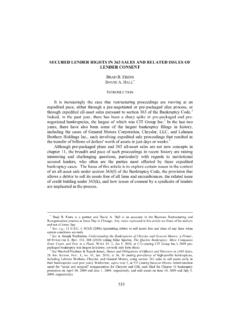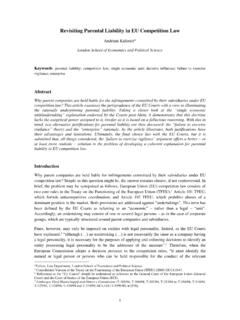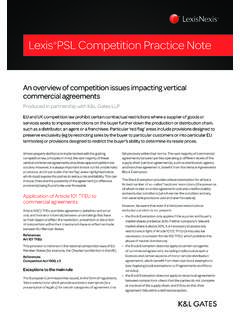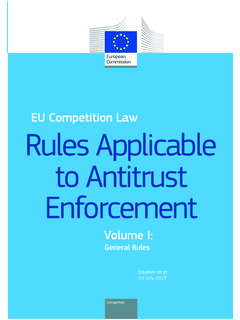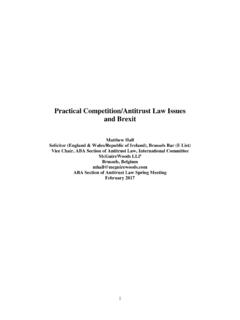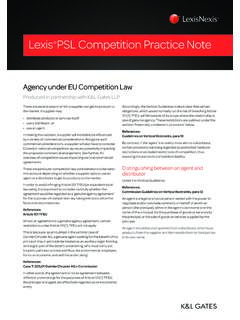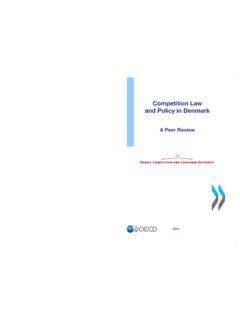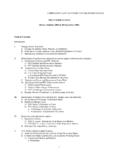Transcription of Antitrust Law and Competition for Distribution
1 09/26/2005 Antitrust Law and Competition for Distribution Joshua D. Wright Abstract An unsettled area of Antitrust law is the regulation of the competitive process for product Distribution and promotion. Competition for Distribution involves vertical contracting with respect to product placement, promotional activity, or the decision to carry a particular product. This process includes controversial practices recently subject to intense scrutiny such as slotting allowances, loyalty discounts, bundled rebates, category management and exclusive dealing.
2 Antitrust law has designed rules for each of these practices independently, ignoring the economic relationships between these business practices. This paper examines those relationships by focusing on the economics of Competition for Distribution . Viewing these practices as part of the competitive process for Distribution exposes an Antitrust policy that systematically mishandles the regulation of these contracts. The article concludes by arguing in favor of per se legality for Distribution contracts foreclosing less than 40% of the market and agreements less than one year in duration.
3 Assistant Professor, George Mason University Law School; , University of California at Los Angeles School of Law, 2001; , University of California at Los Angeles Department of Economics, 2003. I thank Benjamin Klein for valuable discussions, and Bruce Johnsen and Bruce Kobayashi for comments on earlier drafts. Please do not cite or distribute without permission of the author. 1 Table of Contents 1 2 The Economics of Competition for A. Promotional Contracts Solve a Pervasive Incentive Incompatibility Problem B.
4 Transactors Use a Variety of Contractual Mechanisms to Reduce Retailers Incentives to Cheat on the Promotional Contract C. Consumers Benefit from Competition for Distribution 3 Antitrust Regulation of Competition for A. Promotional Payments and Foreclosure Analysis 1. Shelf Space Foreclosure and Space to Sales 2. Robinson-Patman Liability 3. Bundled Rebates as Competition for Distribution B. Exclusivity and Category Management as Bad Conduct C. Operationalizing Naked Exclusion 4 Improving Antitrust A.
5 Safe Harbors for Exclusionary Distribution Contracts 1. The Case for Per Se Legality for Foreclosure less than 40% 2. Short-Term Contracts B. Application to Recent Exclusionary Distribution Cases 5 2 1 Introduction The regulation of the competitive process for product Distribution and promotion is an unsettled and sometimes incoherent area of Antitrust law. One potential explanation for the lack of coherence and consistency in this area is the expansive nature of the subject matter. Marketing and Distribution practices encompass a large and diverse set of contractual relationships between manufacturers and In this sense, the search for a single legal standard sufficient to gauge the competitive impact of this diverse set of practices may be the proximate cause of much of the confusion.
6 A second explanation is that problems in the Antitrust law governing Distribution relationships are caused by a fundamental misunderstanding of the economics of these Distribution relationships, and the competitive process for Distribution more generally. This paper explores this second explanation. For the sake of clarity, I define Competition for Distribution as: manufacturer and retailer contracts involving product placement, promotional activity, or the decision to carry a particular product. Under this definition, Competition for Distribution includes practices such as: manufacturer payments to retailers or other intermediates in the form of discounts or slotting allowances, category management, exclusionary terms, and bundled rebates.
7 A survey of recent Antitrust litigation shows that Competition for Distribution has been the subject of a number of recent Antitrust challenges. The primary contribution of this paper is to show that by focusing on the economics of the contracting environment surrounding the competitive process for product Distribution and retailer promotional services, one can reveal 1 I will refer to retailers as dealers and distributors, while sellers are sometimes referred to as manufacturers.
8 3 previously ignored relationships between the controversial business practices of (1) payments for Distribution , such as slotting allowances, and (2) the use of exclusionary Distribution terms such as exclusivity, partial exclusivity, and category management. Of equal importance, a proper understanding of the competitive process for Distribution exposes an Antitrust policy that systematically mishandles the regulation of Distribution contracts. This paper proposes improvements to this area of the law consistent with the economic insights provided herein.
9 The view that Sherman Act Section 2 ( Section 2 ) standards are potentially harmful to consumer welfare is near universal. Most commentators concede that the standards are, at a minimum, needlessly vague and lead to inconsistent application. The problem is particularly acute in the area of exclusionary Distribution contracts which are currently hampered by a high degree of uncertainty which would be ameliorated by injecting some sensible bright line rules. Part 2 of the paper summarizes the economics of Competition for Distribution , relying heavily on a growing economics literature describing the role of manufacturer payments for distributor promotion and exclusive dealing contracts.
10 This economic framework provides the basis for the legal analysis that follows. Part 3 analyzes the state of modern Antitrust jurisprudence governing Distribution arrangements, emphasizing the recent struggles many courts have had in assessing the likely competitive consequences of manufacturer discounts, slotting allowances, exclusivity, category management, and bundled rebates. Part IV argues that the economics of Competition for Distribution clearly favor safe harbors making per se legal two types of Distribution contracts: short-term 4 contracts less than one year in duration and contracts that foreclose rivals from less than 40% of Distribution opportunities.
